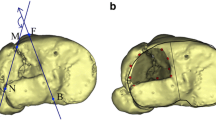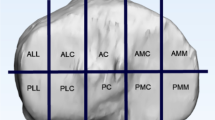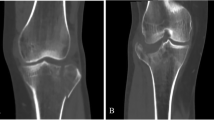Abstract
Purpose
The objective of this study was to evaluate the morphological characteristics of Schatzker type IV tibial plateau fractures.
Methods
A retrospective analysis of radiographic and computed tomographic data of tibial plateau Schatzker type IV fractures from January 2010 to December 2011 was conducted in a level 1 trauma centre. The medial fracture angle (MFA), surface area percentage (SAP), and medial fracture height (MFH) were measured on CT images using the Picture Archiving and Communication System.
Results
Based on the location of fracture and the MFA, 75 cases of Schatzker type IV fracture were divided into three subtypes: anteromedial fracture (seven cases, 9.3 %), total medial plateau fracture (36 cases, 48 %), and posteromedial fracture (32 cases, 42.7 %). The anteromedial fracture was located on the anterior part of the medial plateau, the average MFA was positive 47.5°, the SAP was 38.3 % and the MFH was 41.6 mm. The total medial plateau fracture usually involved the entire medial plateau, the mean value of MFA was 81.2°, the SAP was 53.9 % and the MFH was 64.0 mm. The posteromedial fracture was located on the posterior part of the medial plateau, the MFA was negative 42.5°, the SAP was 32.4 % and the MFH was 44.8 mm.
Conclusion
The direction and location of Schatzker type IV fractures are highly variable. Proper operative approach and fixation method should be selected based on the morphological characteristics of individual medial plateau fractures.





Similar content being viewed by others
References
Schatzker J, McBroom R, Bruce D (1979) The tibial plateau fracture. The Toronto experience 1968–1975. Clin Orthop Relat Res 138:94–104
Moore TM (1981) Fracture–dislocation of the knee. Clin Orthop Relat Res 156:128–140
Bennett WF, Browner B (1994) Tibial plateau fractures: a study of associated soft tissue injuries. J Orthop Trauma 8(3):183–188
Lowe JA, Tejwani N, Yoo B, Wolinsky P (2011) Surgical techniques for complex proximal tibial fractures. J Bone Joint Surg Am 93(16):1548–1559
Barei DP, O'Mara TJ, Taitsman LA, Dunbar RP, Nork SE (2008) Frequency and fracture morphology of the posteromedial fragment in bicondylar tibial plateau fracture patterns. J Orthop Trauma 22(3):176–182. doi:10.1097/BOT.0b013e318169ef08
Higgins TF, Kemper D, Klatt J (2009) Incidence and morphology of the posteromedial fragment in bicondylar tibial plateau fractures. J Orthop Trauma 23(1):45–51. doi:10.1097/BOT.0b013e31818f8dc1
Zeng ZM, Luo CF, Putnis S, Zeng BF (2011) Biomechanical analysis of posteromedial tibial plateau split fracture fixation. Knee 18(1):51–54. doi:10.1016/j.knee.2010.01.006
Fakler JK, Ryzewicz M, Hartshorn C, Morgan SJ, Stahel PF, Smith WR (2007) Optimizing the management of Moore type I postero-medial split fracture dislocations of the tibial head: description of the Lobenhoffer approach. J Orthop Trauma 21(5):330–336. doi:10.1097/BOT.0b013e318055603c
Bhattacharyya T, McCarty LP 3rd, Harris MB, Morrison SM, Wixted JJ, Vrahas MS, Smith RM (2005) The posterior shearing tibial plateau fracture: treatment and results via a posterior approach. J Orthop Trauma 19(5):305–310
Luo CF, Jiang R, Hu CF, Zeng BF (2006) Medial double-plating for fracture dislocations involving the proximal tibia. Knee 13(5):389–394. doi:10.1016/j.knee.2006.05.004
Luo CF, Rui J (2006) Analysis of failed surgical treatment of the medial tibial plateau fractures. Chin J Orthop Trauma 8(7):642–646
De Boeck H, Opdecam P (1995) Posteromedial tibial plateau fractures. Operative treatment by posterior approach. Clin Orthop Relat Res 320:125–128
Wahlquist M, Iaguilli N, Ebraheim N, Levine J (2007) Medial tibial plateau fractures: a new classification system. J Trauma 63(6):1418–1421. doi:10.1097/TA.0b013e3181469df5
Luo CF, Sun H, Zhang B, Zeng BF (2010) Three-column fixation for complex tibial plateau fractures. J Orthop Trauma 24(11):683–692. doi:10.1097/BOT.0b013e3181d436f3
Author information
Authors and Affiliations
Corresponding author
Additional information
Guang Yang and Yi Zhu contributed equally to this study.
Rights and permissions
About this article
Cite this article
Yang, G., Zhu, Y., Luo, C. et al. Morphological characteristics of Schatzker type IV tibial plateau fractures: a computer tomography based study. International Orthopaedics (SICOT) 36, 2355–2360 (2012). https://doi.org/10.1007/s00264-012-1646-y
Received:
Accepted:
Published:
Issue Date:
DOI: https://doi.org/10.1007/s00264-012-1646-y




